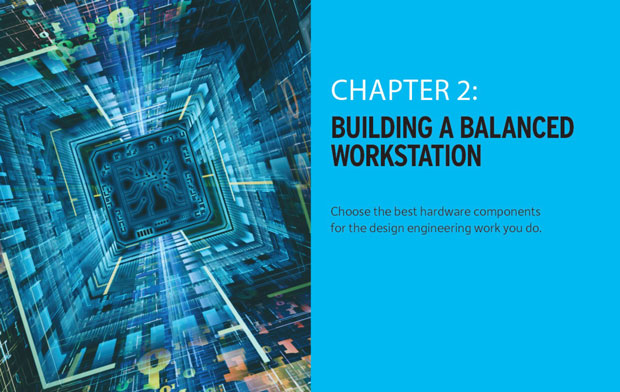Building a Balanced Workstation
Latest News
October 21, 2015
 Dear Desktop Engineering Reader:
Dear Desktop Engineering Reader:
Chapter 2 of “The Design Engineer’s High-Performance Computing Handbook” from Desktop Engineering in partnership with Intel is hot off the PDF-converter and available for download at the far end of today's Check it Out link. It's the most practical document you're likely to read for some time to come.
Titled “Building a Balanced Workstation,” Chapter 2 takes on two big stumbling blocks encountered when purchasing a professional-level, engineering workstation. One, it's easy to overspend for components that you don't need. Two, it's easy to underspend on what you need. Either misstep means you won't get the most out of your software but you will constrain productivity and realize a lousy ROI (return on investment).
The trick is to balance key hardware components – CPU, memory, storage and graphics capabilities – with the demands of your workflow. So, if you run renderings or simulations, you need a different set of CPU and GPU (graphics processing unit) capabilities than you do if you run CAD most of the time.
You likely know all of this in theory. But a general understanding of what needs to be done doesn't help you sort out all the technologies available or make informed decisions. That's where Chapter 2 will shine for you. It's a sharp assemblage of expert advice and technology insights that will help you build a well-balanced workstation tuned for your workflow.
This six-page chapter covers most every technology you hear about: SSDs (solid-state drives), multicore processors, GPUs and even displays. It covers vital issues like software optimization and calculating ROI. It explains your workstation hardware options by matching them to engineering productivity. For example, the speed that a SSD loads big CAD files compared to a hard drive alone is an affordable productivity boost.
 A workstation tuned for CAD, CAE, rendering and simulation workflows increases productivity and remains cost-effective. Chapter 2 of “The Design Engineer’s High-Performance Computing Handbook” explains how you can determine the best hardware for your workflow demands.
A workstation tuned for CAD, CAE, rendering and simulation workflows increases productivity and remains cost-effective. Chapter 2 of “The Design Engineer’s High-Performance Computing Handbook” explains how you can determine the best hardware for your workflow demands.Chapter 2 also looks at important considerations while debunking common wisdom. Take RAM as an example. Everyone knows that you can't have too much memory, right? Well, yeah, but it's not a magic elixir. Maxing out memory does not guarantee maximum performance if your software is not coded to exploit it.
Commonsense and straight talk are the catchwords for Chapter 2 of “The Design Engineer’s High-Performance Computing Handbook.” This chapter will likely be your starting point whenever you consider a hardware upgrade. You can download it, along with Chapter 1, which looks at creating a workflow to support simulation-led design, by hitting today's Check it Out link.
Thanks, Pal. – Lockwood
Anthony J. Lockwood
Editor at Large, Desktop Engineering
Download Chapter 2 of “The Design Engineer's High-Performance Computing Handbook” here.
Subscribe to our FREE magazine, FREE email newsletters or both!
Latest News
About the Author
Anthony J. Lockwood is Digital Engineering’s founding editor. He is now retired. Contact him via [email protected].
Follow DE





